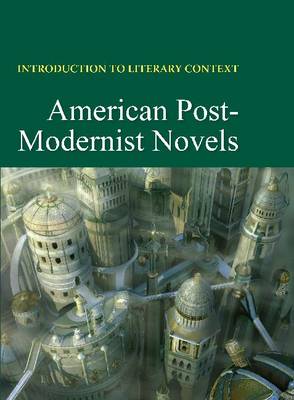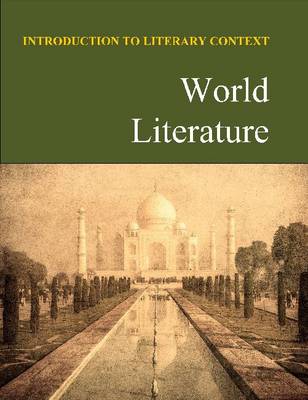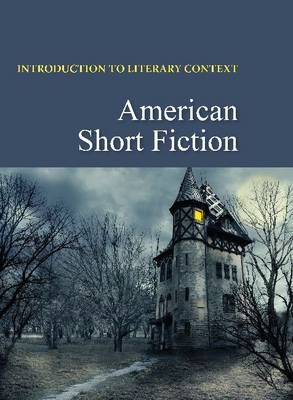Introduction to Literary Context
3 total works
The Introduction to Literary Context series provides introductory overviews of some of the world's best-known works of literature, including novels, short stories, novellas, and poems, placing them in historical, societal, scientific and religious context of their time to deepen understanding and encourage discussion.
This volume introduces literary contexts as they apply to American novels written post 1960, by American and Canadian authors, offering high school and undergraduate students a working foundation of literary context designed to prepare them for more critical literary analysis, such as in Critical Insights. br>
This new series - Introduction to Literary Context -- provides richly detailed essays on significant American post-modernist novels that are studied by upper high school and undergraduate college students. It includes post-modern works by both American and Canadian authors. This volume includes discussion of 36 novels, including: How the Garcia Girls Lost Their Accent (Julia Alverez); Libra (Don DeLillo); Girl, Interrupted (Susana Kaysan); The Red Tent (Anita Diamant); The Handmaid's Tale (Margaret Atwood); Neruomancer (William Gibson); The Naked and the Dead (Norman Mailer); Beloved (Toni Morrison); Zombie (Joyce Carol Oates); Rabbit Run (John Updike); and Jailbird (Kurt Vonnegut). Each essay examines these novels through the following categories: Content Synopsis; Societal Context; Scientific & Technological Context; and Biographical Context. Designed to introduce high school and undergraduate students to these literary concepts, this volume is a valuable forerunner to the more rigorous critical analysis provided in Salem's Critical Insights series. Indeed, many of the novels, authors, and themes covered in Introduction to Literary Context have a companion Critical Insight volume for continued study.
The essays in Introduction to Literary Context: American Post-Modernist Novels also include a list of Complementary Texts, Discussion Questions, and Essay Questions to help students get the most out of their study of these novels.
This volume introduces literary contexts as they apply to American novels written post 1960, by American and Canadian authors, offering high school and undergraduate students a working foundation of literary context designed to prepare them for more critical literary analysis, such as in Critical Insights. br>
This new series - Introduction to Literary Context -- provides richly detailed essays on significant American post-modernist novels that are studied by upper high school and undergraduate college students. It includes post-modern works by both American and Canadian authors. This volume includes discussion of 36 novels, including: How the Garcia Girls Lost Their Accent (Julia Alverez); Libra (Don DeLillo); Girl, Interrupted (Susana Kaysan); The Red Tent (Anita Diamant); The Handmaid's Tale (Margaret Atwood); Neruomancer (William Gibson); The Naked and the Dead (Norman Mailer); Beloved (Toni Morrison); Zombie (Joyce Carol Oates); Rabbit Run (John Updike); and Jailbird (Kurt Vonnegut). Each essay examines these novels through the following categories: Content Synopsis; Societal Context; Scientific & Technological Context; and Biographical Context. Designed to introduce high school and undergraduate students to these literary concepts, this volume is a valuable forerunner to the more rigorous critical analysis provided in Salem's Critical Insights series. Indeed, many of the novels, authors, and themes covered in Introduction to Literary Context have a companion Critical Insight volume for continued study.
The essays in Introduction to Literary Context: American Post-Modernist Novels also include a list of Complementary Texts, Discussion Questions, and Essay Questions to help students get the most out of their study of these novels.
Introduction to Literary Context: World Literature provides richly detailed essays on significant works of literature from around the world that are studied by high school and undergraduate college students. With coverage of both novels and works of short fiction, the essays provide an in-depth examination of the most studied, historical and contemporary works of literature from around the world.
Each 8-10 page concise essay examines each work through the following categories:
The essays in Introduction to Literary Context: World Literature also include a list of Additional Contemporary Novels, Discussion Questions, and Essay Ideas to help students get the most out of their study of these works.
Each 8-10 page concise essay examines each work through the following categories:
- Content Synopsis
- Societal Context
- Scientific & Technological Context
- Biographical Context
The essays in Introduction to Literary Context: World Literature also include a list of Additional Contemporary Novels, Discussion Questions, and Essay Ideas to help students get the most out of their study of these works.
The Introduction to Literary Context series provides introductory overviews of some of the world's best-known works of literature, including novels, short stories, novellas, and poems, placing them in historical, societal, scientific and religious context of their time to deepen understanding and encourage discussion.
This volume introduces literary contexts as they apply to American short fiction from the late 10th century to the present, offering high school and undergraduate students a working foundation of literary context designed to prepare them for more critical literary analysis, such as in Critical Insights.
This new series - Introduction to Literary Context -- provides richly detailed essays on significant American short fiction that is studied by upper high school and undergraduate college students. This volume includes discussion of 39 works of short fiction, including: An Occurrence at Owl Creek Bridge (Ambrose Bierce); Bluebeard's Egg (Margaret Atwood); Everything that Rises Must Converge (Flannery O'Connor); Girl (Jamaica Kincaid); Go Down, Moses (William Faulkner); I Stand Here Ironing (Tillie Olson); Runaway (Alice Monro); Sonny's Blues (James Baldwin); Sweat (Zora Neale Hurston); The Haunting of Hill House (Shirley Jackson); The Lesson (Toni Cade Bambara); The Open Boat (Stephen Crane); The Story of an Hour (Kate Chopin); The Swimmer (John Cheever); To Build a Fire (Jack London); Where I'm Calling From (Raymond Carver); Why I Live at the P. O. (Eudora Welty) and You're Ugly, Too (Lorrie Moore).
Each essay examines these works of short fiction through the following categories: Content Synopsis; Societal Context; Scientific & Technological Context; and Biographical Context. Designed to introduce high school and undergraduate students to these literary concepts, this volume is a valuable forerunner to the more rigorous critical analysis provided in Salem's Critical Insights series. Indeed, many of the works of short fiction, authors, and themes covered in Introduction to Literary Context have a companion Critical Insight volume for continued study.
The essays in Introduction to Literary Context: American Short Fiction also include a list of Complementary Texts, Discussion Questions, and Essay Questions to help students get the most out of their study of these works.
This volume introduces literary contexts as they apply to American short fiction from the late 10th century to the present, offering high school and undergraduate students a working foundation of literary context designed to prepare them for more critical literary analysis, such as in Critical Insights.
This new series - Introduction to Literary Context -- provides richly detailed essays on significant American short fiction that is studied by upper high school and undergraduate college students. This volume includes discussion of 39 works of short fiction, including: An Occurrence at Owl Creek Bridge (Ambrose Bierce); Bluebeard's Egg (Margaret Atwood); Everything that Rises Must Converge (Flannery O'Connor); Girl (Jamaica Kincaid); Go Down, Moses (William Faulkner); I Stand Here Ironing (Tillie Olson); Runaway (Alice Monro); Sonny's Blues (James Baldwin); Sweat (Zora Neale Hurston); The Haunting of Hill House (Shirley Jackson); The Lesson (Toni Cade Bambara); The Open Boat (Stephen Crane); The Story of an Hour (Kate Chopin); The Swimmer (John Cheever); To Build a Fire (Jack London); Where I'm Calling From (Raymond Carver); Why I Live at the P. O. (Eudora Welty) and You're Ugly, Too (Lorrie Moore).
Each essay examines these works of short fiction through the following categories: Content Synopsis; Societal Context; Scientific & Technological Context; and Biographical Context. Designed to introduce high school and undergraduate students to these literary concepts, this volume is a valuable forerunner to the more rigorous critical analysis provided in Salem's Critical Insights series. Indeed, many of the works of short fiction, authors, and themes covered in Introduction to Literary Context have a companion Critical Insight volume for continued study.
The essays in Introduction to Literary Context: American Short Fiction also include a list of Complementary Texts, Discussion Questions, and Essay Questions to help students get the most out of their study of these works.


